1. Advantages of Options

Characters

[Teacher]
An experienced trader who likes trading options more than eating sushi.
An experienced trader who likes trading options more than eating sushi.

[Student]
A novice trader who has invested in stocks but never traded options before.
A novice trader who has invested in stocks but never traded options before.
(1) Advantages in market trends

First, let me ask you a simple question.
What do you do before you invest in stocks?
What do you do before you invest in stocks?

Well, I study information about the company, watching charts and stuff.

You're a good investor, I suppose. We watch charts to analyze which direction the market is going to roughly predict the future price movements.
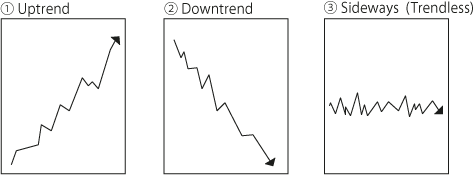




Uptrend indicates that there are more buyers than sellers for that stock.
If the momentum doesn't change, it's likely that the stock price keeps moving up.
Trends are, however, subject to change without notice. So you need to be cautious.
If the momentum doesn't change, it's likely that the stock price keeps moving up.
Trends are, however, subject to change without notice. So you need to be cautious.

I know that surfing an uptrend is the key to success when buying stocks.
That's why I search for a company with a potential for growing.
That's why I search for a company with a potential for growing.
* Making profits in uptrend
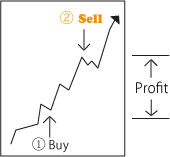


That's right.
Buy cheap. Sell dear. That's how you gain a profit.
Conversely, you can earn profit in downtrend with short selling.
Buy cheap. Sell dear. That's how you gain a profit.
Conversely, you can earn profit in downtrend with short selling.
Note: Short Selling (shorting or going short)
Short selling is a practice of selling stocks that have been borrowed from a third party (usually a broker). After the selling, you must buy back the stocks to return to the third party.
You can make a profit if the stock price goes down after the short selling. If the price goes up, however, there is theoretically unlimited risk of the loss. Unless you are an experienced trader, you should probably NOT use the technique of short selling.
You can make a profit if the stock price goes down after the short selling. If the price goes up, however, there is theoretically unlimited risk of the loss. Unless you are an experienced trader, you should probably NOT use the technique of short selling.
* Making profits in downtrend
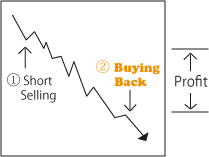


OK, I need to buy stocks and then sell them to make money in uptrend, while I sell first and buy later in downtrend for a profit.

Now, here is a question!!
Is there any way to make a profit in a sideways market, where the prices go nowhere but just level off?
Is there any way to make a profit in a sideways market, where the prices go nowhere but just level off?

Well, they say that traders can profit from tiny movements of the stock market.
Note: Short-Term Trading
A style of trading that attempts to capture gains in short-term price movements.
Those who trade within one to four days are called "swing traders", while "day traders" refer to those who trade on a daily basis.
Those who trade within one to four days are called "swing traders", while "day traders" refer to those who trade on a daily basis.

It's true that short-term trading can bring you profits no matter what the trend is.
The drawback in such trading, however, is that it cannot be used as a long term strategy.
The drawback in such trading, however, is that it cannot be used as a long term strategy.
* In sideways market
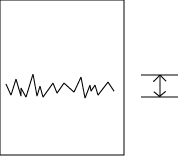

You can collect small profits by scalp trading. In the long term, however, you can't make any profit in sideways markets.

So you mean, there is no long-term strategy I can make a profit with in sideways markets?

There is NO such strategies if you are simply trading stocks.
But don't worry.
Here comes "options".
Using options, you CAN gain a profit even when you are trading in sideways.
But don't worry.
Here comes "options".
Using options, you CAN gain a profit even when you are trading in sideways.
* In sideways market
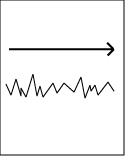

With options, you can take advantage of sideways markets to make money.

Of course, you can gain a profit in uptrend and downtrend with options, but making money in flat markets is one of the unique advantages of trading options.
To put it in more specific terms, you can earn a profit by selling "Call Options" or "Put Options" in sideways markets.
I will later explain those topics in detail.
To put it in more specific terms, you can earn a profit by selling "Call Options" or "Put Options" in sideways markets.
I will later explain those topics in detail.

Now I'm interested.
(2) Advantages in Asset Efficiency -- Leverage

Another unique advantage of options is "leverage".
Note: Leverage
In investment terms, leverage means making large profits from small assets.

What do you mean?

Let's say you bought some stocks for $100 per share, and the price rose to $110 after one month.
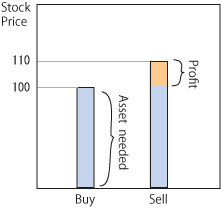
|
If the stock price rose... |

You could gain $10 per share.
And that's 10% profit percentage, since you needed $100 per share in the first place.
And that's 10% profit percentage, since you needed $100 per share in the first place.

If I had bought 10 shares of those, my $1,000 would have become $1,100, right?
What's wrong with that??
What's wrong with that??

If you had traded options, however, you could have made money more efficiently.
In the above example, you could have gained the same (or more) profit with less assets if you had bought call options of the stock instead of directly buying the stocks.
In the above example, you could have gained the same (or more) profit with less assets if you had bought call options of the stock instead of directly buying the stocks.
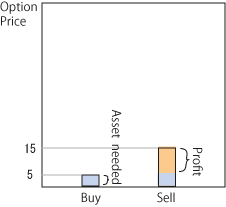
|
If the stock price rose... |

If you buy the options for $5 per contract and sell them for $15, the profit percentage is 200%.

So I need $50 to make $100 profit on the trading.
But this is only because everything goes well, right?
What's the catch?
Like I will lose my house if the stock price goes down??
But this is only because everything goes well, right?
What's the catch?
Like I will lose my house if the stock price goes down??

That's a good question.
Generally speaking, trading with leverage entails lots of risks.
One of the most famous investment instruments with leverage is Futures Trading which has high-risk, high-return characteristics.
Generally speaking, trading with leverage entails lots of risks.
One of the most famous investment instruments with leverage is Futures Trading which has high-risk, high-return characteristics.

In futures trading, traders may suffer a huge loss when the market moves against their positions.
What about options?
What about options?

In the above example, you only lose what you initially invest ($5 per contract) to buy the options even if the company goes bankrupt and the stock price becomes zero.
In other words, you can limit your loss while taking advantage of leverage in options trading.
Having said that, options could be risky when traded in some ways.
That's why you need to understand the mechanism of options before trading them.
In other words, you can limit your loss while taking advantage of leverage in options trading.
Having said that, options could be risky when traded in some ways.
That's why you need to understand the mechanism of options before trading them.

I see. Now I'm starting to realize options are very different from other investments.
- 1. Advantages of Options
- 2. Basics of Options
- 3. Call Option
- 4. Put Option
- 5. Summary of Basics
- 6. Intrinsic Value and Time Value
- 7. Cover Call
- 8. What is Volatility?
- 9. How to take advantage of volatility

